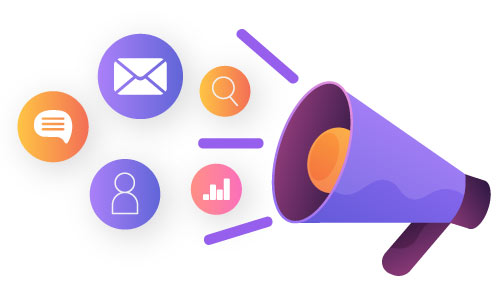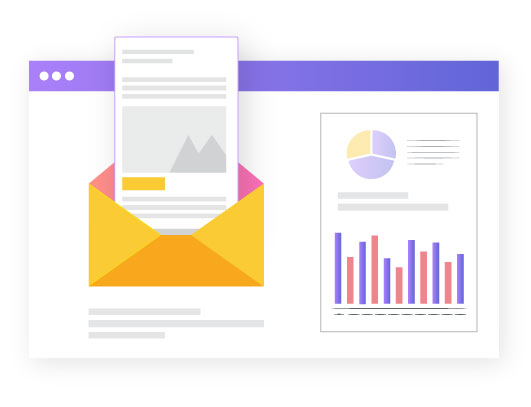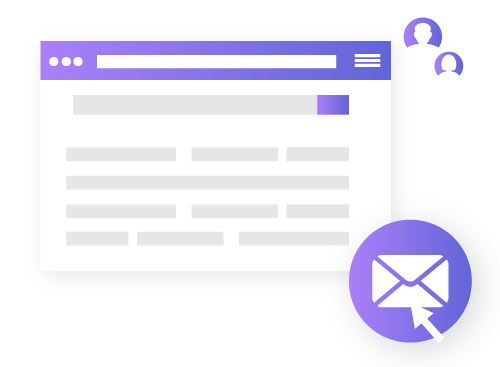Email Marketing is the most primitive method to engage subscribers and customers. Are you aware of the fact that email marketing is nearly 40 years old? The first marketing email was sent by a marketer named Gary Thurek. He sent a promotional email to around 400 people, which generated many leads.
Email marketing is continuing the trend, but automation tools have supported the medium to a greater level due to technological advancements. It has given the medium a new dimension through effective results in terms of ROI.
In fact, pandemic has led marketers to adopt this medium to communicate with prospects and leads. That clearly defines the importance of Email Marketing till now. Read this blog to know how the latest trends and email marketing statistics can influence your business decisions.
Contents
Email Marketing Statistics in 2024

Following the above thread, if we talk about last year’s pandemic crisis, email marketing has undergone a positive transformation, but that too for good. Consequently, email marketers started using many inspiring ways to catch the attention of prospects.
Now that we have entered the year 2024, specific key email marketing trends took a turn due to the covid crisis. Due to the crisis, certain companies shut down while many excelled out of the box.
Below are the trends that resulted due to the unfortunate situation :
- The technical providers and other companies will now focus more on segmentation, Personalization, and automation as they move closer towards one-on-one interaction with the customers.
- Many marketers will use advanced analytics, A.I., and machine learning to make improvements in their strategies. RFM and activity-based modeling are also some of the other techniques.
- On the other hand, cruises, airlines, and traditional retailers will focus more on customer efficiency. They will analyze more of customer behavior based on A/B testing analytics and other optimization techniques.
- More than 50 % of marketers will switch to customized email templates to save up their time and enhance the target audience. These marketers will also use less live content and use more time-intensive technologies such as AMP for Email, which induces more of the production cycles.
How to Plan Marketing Strategy Based On Marketing Trends?
What strategies will you take in 2024 are the results of past years’ trends? As we are still recovering and emerging from the 2020 pandemic, it’s essential to form strategies accordingly.
1. Artificial Intelligence:
It is a trending topic nowadays but it depends on your company’s size and requirements if it is a compulsory strategy for you. A.I. is already giving a lot of benefits to the companies who are using it and investing in it.
2. Customer Experience:

The everlasting impression your customers have about your brand means how customers look up to your brand and how it results in revenue growth.
Note: Apart from providing a seamless customer experience to your website visitors, it’s essential to treat your email users in the same way, so they feel valued.
Put the needs of the customers first and get their loyalty as a reward. Make their journeys seamless by removing all the barriers that are stopping them from purchasing your products. Place empathy in your messages and programs.
3. Personalization:

It is not a new concept that you are using in 2024 for email marketing. But authentic Personalization has been brought back to the spotlight.
Communicate with the customers on a more personal level with email marketing too.
Note: You can automate the personalized emails throughout the customer journey, such as welcome emails, cart abandon emails, and so on.
4. Plain Text-Emails:

The Pandemic has forced marketers to consider the use of time and resources. It has prompted them to use specific old methods back into use if they are giving you the right output.
Fortunately, plain text emails are a go-getter in times of crisis. It saved
What Are The Email Marketing Statistics For The Year 2024?
Below are some of the key email marketing statistics that can influence your marketing strategies:
1. General Email Marketing Statistics
- The average email open rate is 16.97%.
- The average click-through rate (CTR) is 10.29%.
- The average unsubscribe rate is 0.2%.
- The average spam complaint rate is 0.02%.
- The average email marketing ROI is $38 for every $1 spent.
- 79% of marketers use email as their primary channel for generating leads.
- 89% of marketers say that email marketing is essential for their business.
- 91% of consumers check their email daily.
- 64% of small businesses use email marketing to reach customers.
- 52% of consumers prefer to receive promotional emails from their favorite brands every week.
- 49% of consumers say that they are more likely to purchase a brand that sends them personalized emails.
- 72% of consumers exclusively engage with personalized messaging.
- Personalized emails achieve an impressive open rate of 29% and an outstanding click-through rate of 41%.
- Email marketing automation campaigns can increase sales by up to 300%.
- Mobile email opens now account for more than 50% of all email opens.
2. Email Marketing Segmentation Statistics
- According to a study, Marketers who used segmented campaigns saw an increase in their revenues by more than 800%.
- Segmented emails have 20% higher open rates and 11% higher click-through rates.
- 78% of marketers say that subscriber segmentation is the most effective email marketing campaign strategy.
- 57% of marketers say that email personalization has a positive impact on their bottom line.
- 60% of consumers are more likely to do business with a company that personalizes its emails.
- 82% of consumers are frustrated when they receive irrelevant emails.
- During a SuperOffice email marketing experiment, a segmented email campaign earned a 94% open rate and a 38% CTR versus a 42% open rate and 4.5% CTR in a non-segmented email campaign.
- Marketers who segment their email lists report a 760% increase in email revenue.
- 49% of respondents prefer receiving promotional emails from their favorite retail brands every week.
- 60% of consumers are inclined to become repeat buyers after enjoying a personalized shopping experience with a retailer.
- When an email lacks personalization, 52% of customers are willing to seek alternative shopping destinations.
- 57% of marketers attribute improved visitor engagement to the implementation of email personalization.
- 55% of consumers believe receiving targeted promotions and discounts would enhance their email experience.
- Personalized calls to action demonstrate a remarkable 202% increase in click-through rate.
3. AI Email Marketing Statistics
- 68% of marketers are using AI in their email marketing campaigns.
- AI-powered email marketing campaigns have a 20% higher open rate and a 15% higher click-through rate.
- AI can help you personalize your emails, segment your lists, and track your results.
- AI can help you create more engaging and relevant content for your subscribers.
- AI can help you automate your email marketing campaigns, freeing up your time for other tasks.
- AI can help you identify and target your most valuable customers.
- AI can help you prevent spam and improve your deliverability rates.
- AI can help you measure the success of your email marketing campaigns and make improvements.
- The global market for AI email marketing is expected to reach $1.5 billion by 2025.
- 70% of marketers believe that AI will be essential for email marketing success in the future.
- 60% of marketers already use AI in some capacity for email marketing.
4. B2B Email Marketing Statistics
- 59% of B2B marketers consider email marketing as their top revenue-generating channel.
- The average B2B email open rate is 22%.
- The average B2B email click-through rate is 3.2%.
- Email marketing generates $42 for every dollar spent.
- 69% of B2B organizations use email newsletters.
- 78% of B2B marketers use email marketing automation.
- 81% of B2B marketers use email marketing to nurture leads.
- 55% of B2B buyers prefer to receive marketing communications via email.
- 91% of B2B marketers say email marketing is essential for their business.
- Email marketing is 40 times more effective than social media marketing at acquiring customers.
- The average B2B email user checks their inbox 15 times per day.
- The average B2B email user spends 29 minutes per day reading emails.
- The most effective day to send a B2B email is Tuesday.
- The best time to send a B2B email is between 10 a.m. and 11 a.m.
- Personalized B2B emails have an open rate of 20% higher than non-personalized emails.
5. Automated Email Marketing Statistics

- Automated emails have 70.5% higher open rates and 152% higher CTR than other types of email campaigns.
- 67% of marketers say their email marketing automation is “very” or “quite” successful.
- 82% of marketers use automation to create triggered emails which result in 8 times more opens and greater earnings than typical bulk emails.
- 47% of marketers are sure that automation is worth the price.
- 67% of marketers use automation for drip or nurture campaigns; 56% of marketers use automation for segmentation purposes; 45% of marketers use automation for A/B testing.
- 68.5% of responders believe that automation improved the targeting of messages.
- 63% of businesses reduce the frequency of emails send to subscribers based on their levels of engagement.
- Automated welcome emails have an open rate of 81% and a click-through rate of 20%.
- Automated abandoned cart emails have a recovery rate of 15-30%.
- Automated birthday emails have an open rate of 45% and a click-through rate of 21%.
- Automated win-back emails have a recovery rate of 20-30%.
- Automated cross-sell and upsell emails have a click-through rate of 10-15%
- Automated customer service emails have a response rate of 90%.
- Automated marketing emails have a click-through rate of 5-7%.
- The average cost of an automated email campaign is $0.50 per email.
6. B2C Email Marketing Statistics

- 80% of consumers prefer to receive marketing communications from brands via email.
- The average B2C email open rate is 19.7%.
- The average B2C email click-through rate is 6.3%.
- Email marketing generates $38 for every dollar spent.
- 59% of consumers have purchased as a result of an email marketing campaign.
- 67% of consumers say they are more likely to do business with a company that sends them personalized emails.
- 75% of consumers are more likely to open an email from a brand if the subject line is personalized.
- 58% of consumers say they are more likely to click on a link in an email if the text is personalized.
- The best day to send a B2C email is Tuesday.
- The best time to send a B2C email is between 10 a.m. and 11 a.m.
- Personalized B2C emails have an open rate of 15% higher than non-personalized emails.
- Emails with images have an open rate of 10% higher than emails without images.
- Emails with a call to action have a click-through rate 20% higher than emails without a call to action.
- Emails with a clear and concise subject line have an open rate of 30% higher than emails with a vague or confusing subject line.
- Emails that are relevant to the recipient’s interests have an open rate of 50% higher than emails that are not relevant.
The Most Effective Time to Send Promotional Emails Statistics
Time of Day:
- Morning: Studies indicate higher open and click-through rates between 8 am and 10 am.
- Afternoon: 1-3 pm is quite effective for B2B audiences.
- Early evening: 5 pm-7 pm might also work for reaching customers after working hours.
Day of the Week:
- Tuesday and Wednesday: These weekdays usually have lower email volume, leading to more email visibility.
- Weekend mornings: Saturdays and Sundays might boost engagement for leisure-related products or services.
Conclusion:
The above email marketing statistics show that the medium is adaptable to change, and you can integrate other tools to get effective results.
Consequently, you can meet the needs of consumers in the ever-changing digital landscape. Also, with these email marketing statistics trends, you can change your marketing strategies.
Also Read:
- 17 Best Email Marketing Apps for Shopify
- 20 Best Email Marketing Software and Tools
- Web Push Notifications | A Direct Email Marketing Tactics
- How Does Email Marketing Improve Customer Retention?

























 Email
Email SMS
SMS Whatsapp
Whatsapp Web Push
Web Push App Push
App Push Popups
Popups Channel A/B Testing
Channel A/B Testing  Control groups Analysis
Control groups Analysis Frequency Capping
Frequency Capping Funnel Analysis
Funnel Analysis Cohort Analysis
Cohort Analysis RFM Analysis
RFM Analysis Signup Forms
Signup Forms Surveys
Surveys NPS
NPS Landing pages personalization
Landing pages personalization  Website A/B Testing
Website A/B Testing  PWA/TWA
PWA/TWA Heatmaps
Heatmaps Session Recording
Session Recording Wix
Wix Shopify
Shopify Magento
Magento Woocommerce
Woocommerce eCommerce D2C
eCommerce D2C  Mutual Funds
Mutual Funds Insurance
Insurance Lending
Lending  Recipes
Recipes  Product Updates
Product Updates App Marketplace
App Marketplace Academy
Academy

